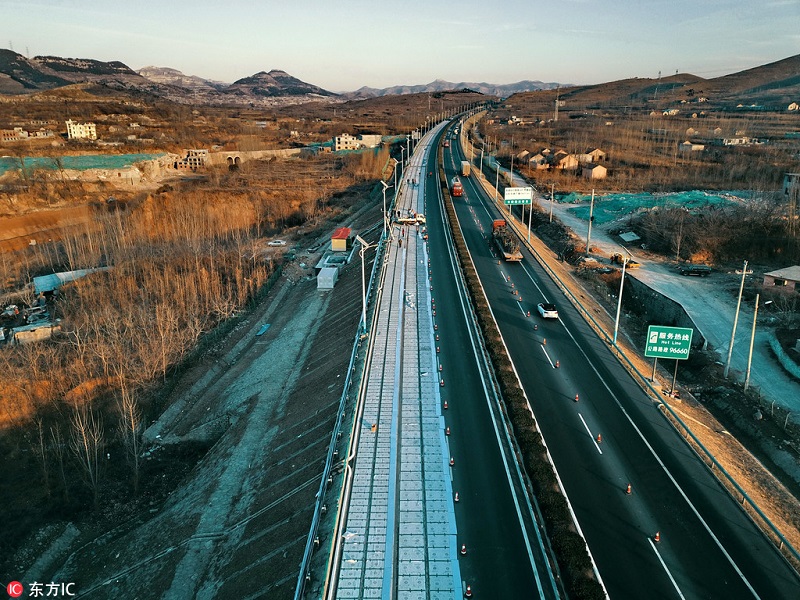The relationship between China and solar power is set to skip merrily down a new path over the next few days as construction workers put the final pieces in place of a 2km solar-powered highway in the city of Jinan.
According to reports in the Chinese media including the People’s Daily Online and Jiemian News, the highway will be completed before the end of December by Qilu Transportation Development Group, which is a state-owned transport firm operating in Shandong, a province in eastern China.
The road’s composition is made of three distinct layers, with transparent concrete on top protecting the solar panels beneath. The bottom layer is a strip of insulation that will protect the panels from the earth’s elements. Chinese solar inverter firm Growatt has supplied its string inverters for the project.
The Jinan South Ring Expressway creeps into the city and will not only plug into the grid but will also serve as a research prototype, with engineers from Tongji University – who developed the core technology for the project – stressing that in the future this solar-powered stretch of road could actually charge electric vehicles as they drive along it.
Tongji University professor of transportation engineering Zhang Hongchao said that he hopes the solar highway can kickstart the development of a national network of smart roads that would become “mobile solar charging treasures” able to not only power vehicles but also provide pre-emptive technical support, manage driverless fleets and harvest big data to smooth traffic flows.
This project follows on from a 660-square meter solar-powered pavement developed in Jinan earlier this year to test the university’s solar-powered concrete slabs, which boast anti-skid performance and the ability to use some of the electricity gleaned to heat up and thus melt snow and ice before it forms.
Solar roads are a relatively young technology, at least in terms of achieving commercialization. The first completed roadway in the world was built in 2014 in the Netherlands at Cromane – a 70-meter solar-powered cycle path. In late 2016 France officially unveiled its €5 million, 1km stretch of solar road, developed by COLAS, while in the U.S., SolarRoadways has equipped a short sidewalk near Route 66 in Missouri with hexagonal solar panels embedded with multi-layered LED lights.
While popular on social media, delivering undoubtedly rich visceral treat to viewers, solar experts are divided on the long-term viability of solar roadways. Some argue that they are little more than mere gimmicks that actually harm the image of solar power as a scalable, affordable and mainstream source of energy in the long run. Others, however, believe that if the busy arteries of cities can begin ‘paying their way' with PV, then the technology could prove adept at lowering CO2 emissions and boosting the uptake of electric vehicles.
This content is protected by copyright and may not be reused. If you want to cooperate with us and would like to reuse some of our content, please contact: editors@pv-magazine.com.



2 comments
By submitting this form you agree to pv magazine using your data for the purposes of publishing your comment.
Your personal data will only be disclosed or otherwise transmitted to third parties for the purposes of spam filtering or if this is necessary for technical maintenance of the website. Any other transfer to third parties will not take place unless this is justified on the basis of applicable data protection regulations or if pv magazine is legally obliged to do so.
You may revoke this consent at any time with effect for the future, in which case your personal data will be deleted immediately. Otherwise, your data will be deleted if pv magazine has processed your request or the purpose of data storage is fulfilled.
Further information on data privacy can be found in our Data Protection Policy.